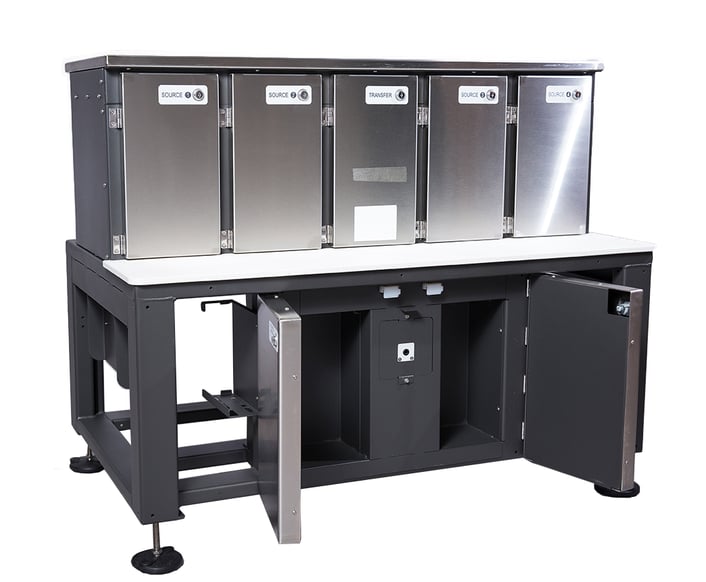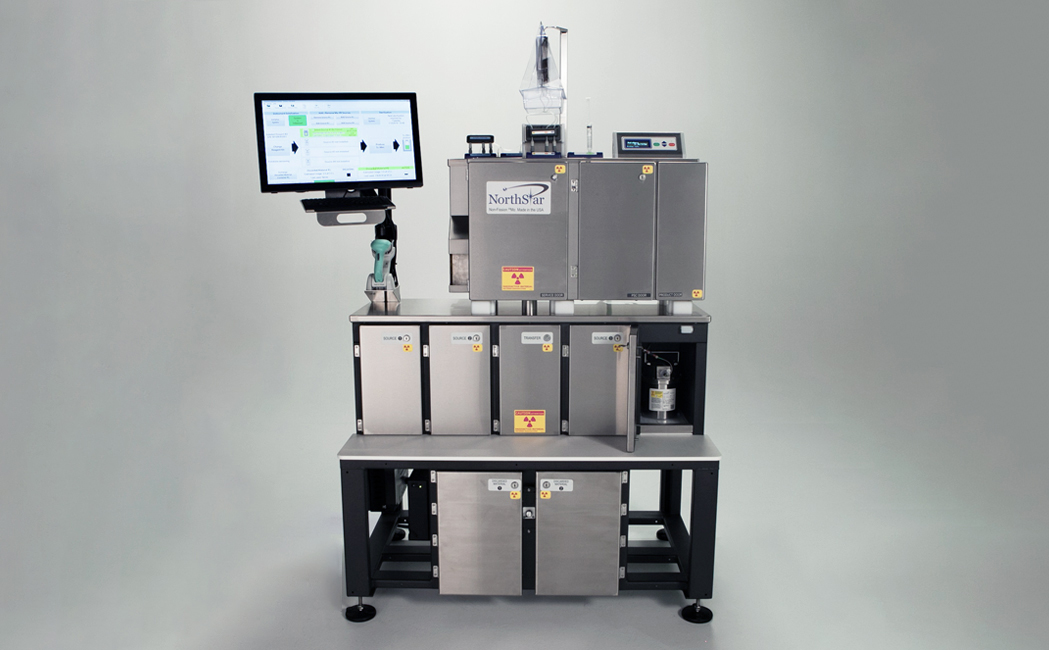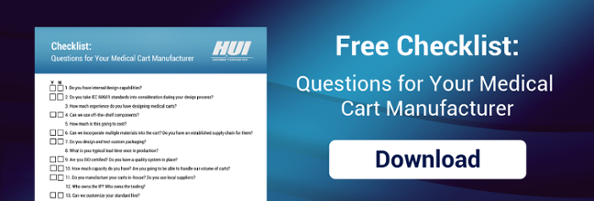This is our latest case study on a custom medical chassis the HUI team designed for NorthStar® Medical Radioisotopes, LLC.
Background Information
Based in Beloit Wisconsin, NorthStar® Medical Radioisotopes, LLC is a nuclear medicine technology company. Founded in 2006, the company is a wholly-owned subsidiary of NorthStar Medical Technologies, LLC. They provide the U.S. with stable, domestic, and environment friendly radioisotope supply solutions to meet the needs of patients and advance clinical research. (source: https://www.northstarnm.com/company/#history)
Before NorthStar developed their innovative system, people in the U.S. were only able to secure medical radioisotopes with uranium-based materials. Due to the danger of the use of uranium in weapons, the National Nuclear Security Administration (NNSA) wanted to reduce the risk as soon as possible. They offered cooperative agreement funds in 2010 for companies who could produce medical radioisotopes without the risk of nuclear grade materials getting in the wrong hands.
NorthStar Medical Radioisotopes, LLC received two cooperative agreements from the NNSA, providing them with funds to develop their RadioGenix® System, which is a technetium Tc-99m generator used to produce Sodium Pertechnetate Tc 99m Injection, USP. It is the first and only non-uranium based system for the production of technetium-99m (Tc-99m) in the United States in more than 25 years. (source: https://www.northstarnm.com/products/northstar-solutions-radiogenix-system/)
Learn More
To learn more about RadioGenix® System and its imaging capabilities please visit: https://www.northstarnm.com/products/northstar-solutions-radiogenix-system/
Our Challenge
NorthStar contacted HUI to develop a highly regulated chassis to house their RadioGenix® System. They needed the chassis to hold several thousand pounds, secure lead shielding to prevent any radiation leaks, and they needed the engineering design of the chassis as well as a production-grade prototype in roughly three months.

The Obstacles
-
Short timeline: NorthStar provided an engineering concept to HUI, but our engineers still only had three months to develop both a chassis and a trolley to effectively prevent radioactive material leakage. The chassis also had to fit through doorways and provide easy installation.
-
Shielding users from the radioactive material: This project required a great understanding of sheet metal fabrication, because the sheet metal had to have removable panels to allow installation of lead to protect the users from unintentional radiation exposure.
-
Lead enclosure design: NorthStar asked our design engineer to create an enclosure that allows trained installation personnel to take the enclosure apart at the nuclear pharmacy customer site to install the lead radiation shielding so there are no open areas for radiation leakage.
-
Weight requirements: The chassis had to support several thousand pounds because of all the lead that’s added onto the system. The team had to design the chassis so it wouldn’t buckle under the weight.
-
Durable sliding trays: The radioactive materials are stored in heavy shielded vessels, so they needed a way for the nuclear pharmacy workers to be able slide the vessels into the chassis with minimal effort and without the vessel slides deteriorating over time.
-
Problems with a machined plastic part: For a machined plastic part on the chassis, some batches would turn out fine then randomly other plastic pieces would curve like a banana. We were having a problem determining the cause.
-
Moving and fitting the chassis through their door frames: They needed to be able to move the chassis with a pallet jack into a clean room environment, because the shielding made the chassis very heavy. They also needed the chassis to fit through their door frames.
The Solutions
-
Short timeline: Our engineers expedited the process by working at NorthStar’s facility so they could get answers as soon as they were available. At the time NorthStar’s engineers were still working on parts of the RadioGenix® System design. We continued to overlap steps at HUI. For example, at one point one engineer was working on finishing the design, while our other engineers were already getting started on the prints. Our team even beat out a carpentry company who was making a wood model of the chassis, if we couldn’t finish the final product in time. We finished out the chassis design first, because we were able to optimize our time throughout the project.
-
Shielding users from the radioactive material: Our Design Engineer knew how to work with sheet metal and lead to contain the radioactive material. He added some standoffs to the enclosures. He also added more of the polystyrene plastic to the inside of the enclosure as well as the enclosure door to prevent end-user access to the lead shielding.
-
Lead enclosure design: Most design engineers would have had a hard time designing the lead enclosure to fit their requirements, but our engineer, Dwayne Beckmann, was able to find the perfect solution for preventing radiation leaks. He made an enclosure design that was easy for the trained installation personnel to safely take the sheet metal covers off and replace once the lead bricks were installed. He also created the innovative design in less than a month, keeping the project on track.
-
Weight requirements: We did some cycle testing with concrete weight and Silica Sand to test out how the chassis would handle all of the weight. We loaded the main chassis with over 7,000 lbs. and it passed with no noticeable deflection. Then we tested the source bay’s ability to hold 1800 lbs. and it passed with no noticeable change, and the doors operated normally. You can watch the weight tests in this video:
-
Durable sliding trays: Our team had to find materials that would allow for low friction while still being strong enough to safely support the heavy vessels. Our engineers performed cycle tests to find the best solution by putting a weight plate on the ideal materials and pulling and pushing it back and forth repeatedly. Our tests resulted in changing the design of the material.
-
Problems with a machined plastic part: We learned that all materials have their quirks and solved this problem by changing the design. We found out the root cause of the curved parts was due to the fact we were machining out such large pockets of plastic. We had to reduce the amount of machining in one pass, so we could prevent this deformation.
-
Moving and fitting the chassis through their door frames: We designed the chassis to easily fit through a door frame. We also ran some tests to make sure they can safely transfer the chassis on a pallet jack without damaging the chassis.
The Outcome
- HUI was able to create a successful engineering design and build a manufacturable system that passed FDA testing by effectively protecting people from unintentional radiation exposure.
- NorthStar and the HUI team worked together to accelerate the development process to only three months. The project started in September and NorthStar received four prototypes by early November.
- HUI also built the chassis to safely accommodate the large amount of weight it has to hold, and used cycle testing to make sure it would hold up in the long-run.
- The HUI team worked with multiple materials and gained more experience about the quirks of each material. The final chassis had stainless steel, vinyl, steel, aluminum, 3-D printed parts, and three different kinds of plastic.
- Our Design Engineer, Dwayne Beckmann, was able to use his experience to quickly find design solutions for some difficult obstacles. From the lead enclosure design to the sheet metal fabrication, we learned that experience and knowledge were the key factors in hitting NorthStar’s accelerated deadlines.
Testimonial
“The people are considerate, professional, and enjoyable to work with. I would recommend HUI to someone building a medical system because of their attention to detail. The best part about working with HUI is that the team is always willing to be creative. So often companies look to the customer for ideas, while the HUI team was never afraid to present new thoughts or test out new ideas.
We gave them what we thought was an impossible deadline of 9 weeks, and they kept their word. Mark and Dwayne came to work on-site at NorthStar to get the project done on time. We had the design from them in 4 weeks, and we had the prototypes in 8 weeks. There were a lot of skeptics on our team that HUI had to prove wrong, and in the end they blew everyone away.” - Ray Heasty
If you’d like to learn more, or if you want to work with the HUI team on your custom medical chassis, cart, or system solution, please contact us today.


